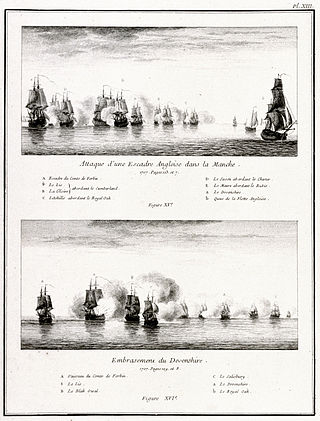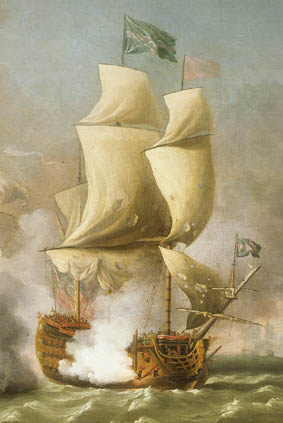
HMS Cambridge was an 80-gun third-rate ship of the line of the Royal Navy, designed by Sir Joseph Allin and built at Deptford Dockyard by Adam Hayes to the draught specified by the 1745 Establishment as amended in 1750, and launched on 21 October 1755.

HMS Charles was a 96-gun first-rate ship of the line of the Royal Navy, built by Christopher Pett at Deptford Dockyard until his death in March 1668, then completed by Jonas Shish after being launched in the same month. Her name was formally Charles the Second, but she was known simply as Charles, particularly after 1673 when the contemporary Royal Charles was launched.

HMS Salisbury was a 50-gun fourth rate ship of the line of the Royal Navy, built by Richard and James Herring at Baileys Hard on the Beaulieu River in Hampshire, England, and launched on 18 April 1698.

HMS Captain was a 70-gun third rate built at Woolwich Dockyard in 1677/78. After sitting in Ordinary for ten years she was in active commission for the War of the English Succession fighting at Beachy Head and Barfleur. She was in Ordinary until 1706 when she was rebuilt. She was in active commission for the last half of the War of Spanish Succession but fought in no major engagements. She was at the Battle of Passero I 1718. She was rebuilt in 1720/22. She made two forays in to the Baltic though the bulk of her late career was spent as guardship at Portsmouth. She was hulked in 1740 and finally broken in 1762.

HMS Lancaster was an 80-gun third rate ship of the line of the Royal Navy, launched at Bursledon on 3 April 1694.

HMS Canterbury was a 60-gun fourth-rate ship of the line of the Royal Navy, launched at Deptford on 18 December 1693.

HMS Barfleur was a 90-gun second rate ship of the line of the Royal Navy, launched at Deptford Dockyard on 10 August 1697.

HMS Severn was a 50-gun fourth-rate ship of the line of the Royal Navy, launched at Blackwall Yard in 1695.
HMS Falmouth was a 50-gun fourth-rate ship of the line built for the Royal Navy in the first decade of the 18th century. The ship participated in several battles during the War of the Spanish Succession (1701–15) and the War of Jenkins' Ear (1739–48).

HMS Gloucester was a 50-gun fourth-rate ship of the line built at Deptford by Joseph Allin the elder for the Royal Navy in 1710/11. She participated in the War of the Spanish Succession. The ship was burned to prevent capture after she was damaged in a storm during Commodore George Anson's voyage around the world in 1742.

HMS Bristol was a 50-gun fourth-rate ship of the line built for the Royal Navy in the first decade of the 18th century.
The 1719 Establishment was a set of mandatory requirements governing the construction of all Royal Navy warships capable of carrying more than 20 naval long guns. It was designed to bring economies of scale through uniform vessel design, and ensure a degree of certainty about vessel capability once at sea, and was applied to all vessels from the first-rate to the fifth-rate. Once in effect, it superseded the 1706 Establishment, which had specified major dimensions for ships of the second-rate, third-rate and fourth-rate only.

The 1745 Establishment was the third and final formal establishment of dimensions for ships to be built for the Royal Navy. It completely superseded the previous 1719 Establishment, which had subsequently been modified in 1733 and again in 1741. Although partially intended to correct the problems of the ships built to the earlier Establishments, the ships of the 1745 Establishment proved just as unsatisfactory, and important changes in the make-up of the Admiralty and Navy Boards finally led to the end of the establishment era by around 1751.
HMS Aldborough was a 24-gun sixth-rate ship of the Royal Navy, purchased in 1706 and in service in Mediterranean and English waters until 1727 when she was rebuilt as a 374 ton sixth rate in accordance with the 1719 Establishment for Sixth Rates. After the rebuild she spent her career in the West Indies, Home Waters and the Mediterranean. She was finally broken at Deptford on 31 March 1742.
HMS Seaford was a member of the standardized 20-gun sixth rates built at the end of the 17th century. After she was commissioned she had a very varied career, starting in the Mediterranean then the Irish Sea, then to Newfoundland, the North Sea followed by a great repair then to the Leeward Islands. She was dismantled in 1722 and rebuilt as a bomb vessel in 1727 than a 20-gun sixth rate in 1728. She served in the West Indies, America and the Mediterranean. She was finally broken in 1740.
HMS Lively was a member of the Gibraltar Group of 24-gun Sixth Rates. After commissioning she spent her career in Home waters on trade protection duties. She was broken in 1738.
HMS Rye was a member of the 1719 Establishment Group of 20-gun sixth rates. After commissioning she spent her career in Home waters on trade protection duties. She was broken up in 1735.
HMS Greyhound was a member of the 1719 Establishment Group of 20-gun sixth rates. After commissioning she spent the first part of her career in North America and the West Indies. Later she was in Home Waters and finishing in the Mediterranean on trade protection duties. She was sold at Deptford in October 1742.
HMS Experiment was a fifth rate built under the 1689 programme built at Deptford Dockyard. Her guns were listed under old terms for guns as demi-culverines, sakers and minions. After commissioning she spent her career in Home Waters, North America, Mediterranean and the West Indies. She was reduced to a 20-gun sixth rate in 1717 then rebuilt as a 1719 Establishment sixth rate in 1724. Her breaking was finally completed at Portsmouth in 1738.
HMS Lyme was a 32-gun fifth rate built by Mr. Flint of Plymouth in 1694/95. She spent her career on counter piracy patrols and trade protection duties in Home Waters, the Mediterranean and in North America and the West Indies. She was rebuilt to the 1719 Establishment as a sixth rate in 1720/21. Her breaking was completed in January 1739.









